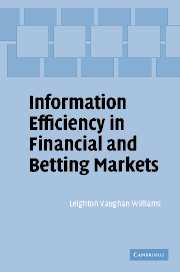Book contents
- Frontmatter
- Contents
- List of figures
- List of tables
- List of contributors
- Introduction
- Part I The concept of information efficiency
- Part II Selected readings
- 4 An assessment of quasi-arbitrage opportunities in two fixed-odds horse-race betting markets
- 5 The presence of favourites and biases in bookmakers' odds
- 6 Searching for semi-strong form inefficiency in the UK racetrack betting market
- 7 Models, markets, polls and pundits: a case study of information efficiency
- 8 Longshot bias: insights from the betting market on men's professional tennis
- 9 Biases and insider trading in exotic bets on thoroughbreds
- 10 On the improbability of information efficient parimutuel betting markets in the presence of heterogeneous beliefs
- 11 Modelling gambling demand in a laboratory casino: discovering the importance of individual-specific effects
- 12 Market efficiency of the 50–30–20–10 horse-racing spread betting market
- 13 Insider trading and bias in a market for state-contingent claims
- 14 Rationality and efficiency in lotto games
- 15 Efficiency of the odds on English professional football matches
- 16 Modelling distance preference in flat racing via average velocity
- 17 Testing for market efficiency in gambling markets: some observations and new statistical tests based on a bootstrap method
- 18 Information (in)efficiency in prediction markets
- Index
- References
7 - Models, markets, polls and pundits: a case study of information efficiency
Published online by Cambridge University Press: 09 July 2009
- Frontmatter
- Contents
- List of figures
- List of tables
- List of contributors
- Introduction
- Part I The concept of information efficiency
- Part II Selected readings
- 4 An assessment of quasi-arbitrage opportunities in two fixed-odds horse-race betting markets
- 5 The presence of favourites and biases in bookmakers' odds
- 6 Searching for semi-strong form inefficiency in the UK racetrack betting market
- 7 Models, markets, polls and pundits: a case study of information efficiency
- 8 Longshot bias: insights from the betting market on men's professional tennis
- 9 Biases and insider trading in exotic bets on thoroughbreds
- 10 On the improbability of information efficient parimutuel betting markets in the presence of heterogeneous beliefs
- 11 Modelling gambling demand in a laboratory casino: discovering the importance of individual-specific effects
- 12 Market efficiency of the 50–30–20–10 horse-racing spread betting market
- 13 Insider trading and bias in a market for state-contingent claims
- 14 Rationality and efficiency in lotto games
- 15 Efficiency of the odds on English professional football matches
- 16 Modelling distance preference in flat racing via average velocity
- 17 Testing for market efficiency in gambling markets: some observations and new statistical tests based on a bootstrap method
- 18 Information (in)efficiency in prediction markets
- Index
- References
Summary
In this chapter, I will offer a brief perspective on alternative methodologies designed to gauge the state of the 2004 US Presidential election race at a given point in time and to forecast the outcome of the race. At the time of final data collection and completion (Tuesday, 5 October 2004) the election is four weeks away. The reader can make some judgement of the relative and absolute merits of the alternative methodologies with the advantage of the actual results to hand.
Section 7.1 considers econometric models and section 7.2 considers polling evidence. Section 7.3 considers the forecasts of a panel of ‘experts’. Section 7.4 examines evidence from the various betting markets. Section 7.5 summarises the findings, and concludes.
Econometric studies
The application of economic indicators to forecast election outcomes can be traced to Kramer (1971) and Stigler (1973) for US congressional election, to Fair (1978) and Hibbs (1982) for US Presidential elections and to Lewis-Beck (1988) and Palmer and Whitten (1999) for elections in other industrialised countries.
A survey of economic models for predicting Australian elections (Wolfers and Leigh, 2002) indicates the importance of including unemployment and inflation as key factors in the forecasting mix, with Jackman and Marks (1994) noting an additional incumbency advantage. Jackman (1995) includes a ‘honeymoon’ effect for novice governments and Cameron and Crosby (2000) the impact of the world wars.
- Type
- Chapter
- Information
- Information Efficiency in Financial and Betting Markets , pp. 193 - 214Publisher: Cambridge University PressPrint publication year: 2005
References
- 1
- Cited by



